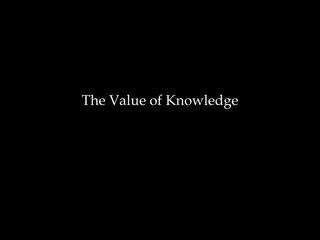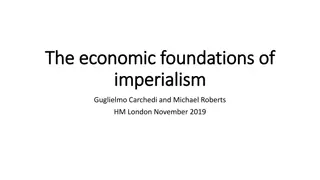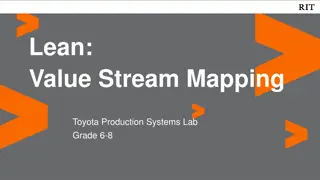Understanding the Value of Microcredentials in Education
Microcredentials serve as valuable confirmations of specific skills acquired through diverse learning experiences, allowing individuals to distinguish themselves in the competitive education and professional landscape. They inspire ongoing development, document skillsets obtained beyond job scopes, and help build digital portfolios. Open Badges, an innovative standard, encapsulate verified achievements and competencies digitally, facilitating skill presentation, tracking development, and enhancing global recognition. Embrace the power of microcredentials for personal and professional growth.
Download Presentation

Please find below an Image/Link to download the presentation.
The content on the website is provided AS IS for your information and personal use only. It may not be sold, licensed, or shared on other websites without obtaining consent from the author. Download presentation by click this link. If you encounter any issues during the download, it is possible that the publisher has removed the file from their server.
E N D
Presentation Transcript
Innovative solutions in education Microcredentials are a confirmation of smaller learning outcomes (smaller than, for example, university diplomas or postgraduate certificates). They allow the confirmation of acquiring new skills or expanding already acquired ones. Skills not only include those resulting from formal education at school or university, or during various courses but also those gained, for instance, through self-directed learning.
Why collect microcredentials? Microcredentials allow the confirmation of specific skills. Microcredentials enable individuals to stand out from the crowd with similar education and professional experience. Microcredentials serve as motivation for continuous development. For example, individuals participating in scientific conferences or other educational events gain a substantial amount of new valuable information microcredentials allow them to document this. Microcredentials offer a chance for individuals working in specific positions, but actually performing additional tasks beyond their duties, to confirm skills beyond their job scope. Microcredentials are now issued by schools, universities, reputable institutions, and companies based on transparent criteria, making them unquestionable and always in favor of the holder. Microcredentials build individual digital portfolios for each person.
Open Badges Open Badges is an innovative international standard for digitally certifying verified achievements, skills, or competencies. This standard is based on an attractive form of digital microcredentials with encoded and secured information necessary to identify what the microcredential is for, who received it, and who issued it. All this information acts as a "fingerprint" in the job market. Thanks to them, we can track the educational and professional development of an individual. The ability to collect or share them online allows for a simpler and faster way to present our skills portfolio than before. In addition, microcredentials provide the opportunity to build motivation, track development paths and educational achievements, as well as raise awareness of competencies. Businesses, institutions, and NGOs worldwide benefit from them.
Open Badges - - - - - - - - - - - Name of badge or microcredential Publisher (publisher details) Holder (holder s details) Description of the badge or microcredential Graphical image Criteria of awarding Date of release Tags Evidence of meeting the criteria Expiration date URL
First aid (The power to rescue, Lifesaver Basic Level) Badge class data First aid ( The power to rescue, Lifesaver Basic Level) The badge holder participated in a course titled "First Aid" organized by the Wroclaw Medical University. During the course, the badge holder acquired theoretical and practical knowledge regarding the provision of first aid. The course is divided into three parts. The first module focuses on basic life- saving procedures, BLS recognizing a person in a life-threatening condition, alternate ventilation (using a face mask, face shield), chest compressions, and the recovery position. The second module deals with the the operation of an automated external defibrillator along with BLS elements. The content presented in the first and second parts aligns with the current ERC 2021 guidelines. Additionally, within the third module, instructors address issues related to first aid in the context of incidents that may occur on the company's premises. Course participants undergo continuous assessment by qualified instructors.
First aid (The power to rescue, Lifesaver Basic Level) Criteria 1. Participation in the "First Aid" course with a minimum duration of 4 instructional hours, 2. The course participant can correctly notify the Emergency Medical Team, 3. The course participant can correctly assess basic life functions, 4. The course participant can correctly position the casualty in a safe posture, 5. The course participant can determine when to initiate artificial ventilation, 6. The course participant can correctly perform cardiopulmonary resuscitation (BLS), 7. The course participant can apply a strategy for the safe and effective use of an AED, 8. The course participant can apply a strategy for responding to choking incidents, 9. The course participant can apply a strategy for providing assistance in case of injuries, 10. The course participant can apply a strategy for providing assistance in life-threatening non-traumatic situations, 11. The course participant can apply a strategy for providing first aid in the workplace
Sample course suggestions for microcredentials 1.ECMO Course 2.Invasive Mechanical Ventilation Course for Patients 3.Laryngoscopic Examination Course 4.Ultrasound (USG) Course 5.FAST Ultrasound Course 6.Echocardiography Course 7.Suturing Course: Skin sutures, fascial sutures, intestinal sutures Ranks : 1. Theoretical basics 2. Supervised operation 3. Independent operation 1.Conference badges 2.Scientific activity badges 3.Medical language badges: a) sign language b) german language c) english language d) swedish language
European principles for the development and issuance of microcredentials QUALITY based on the effectiveness of the internal quality assurance procedures of the course organizer. TRANSPARENCY microcredentials provide clear information about learning outcomes, workload, content, level, and educational offerings. RELEVANCE relevant to the job market and educational needs. ASSESSMENT - based on transparent criteria. LEARNING PATHWAYS microcredentials are developed and issued to support the flexibility of learning paths, including the possibility of validation, recognition, and "communication" of microcredentials from different systems. RECOGNITION recognized based on standard recognition procedures applied to recognizing foreign qualifications and periods of study abroad or following standard European elements for describing and principles for developing and issuing microcredentials.
European principles for the development and issuance of microcredentials PORTABILITY is a property of the credential holder (learner) and can be stored and shared by them, including through secure digital wallets (e.g. Europass). LEARNER-CENTRICITY microcredentials are developed to meet the needs of the target group of learners. AUTHENTICITY microcredentials contain sufficient information to verify the identity of the credential holder, the legal identity of the issuing body, and the date and place of issuance of the microcredential. INFORMATION AND GUIDANCE should inclusively reach as many learner groups as possible, supporting education, training, and career choices.
Thank you for your attention. mgr in . Agnieszka Wasilewska Director Postgraduate Education Center

























